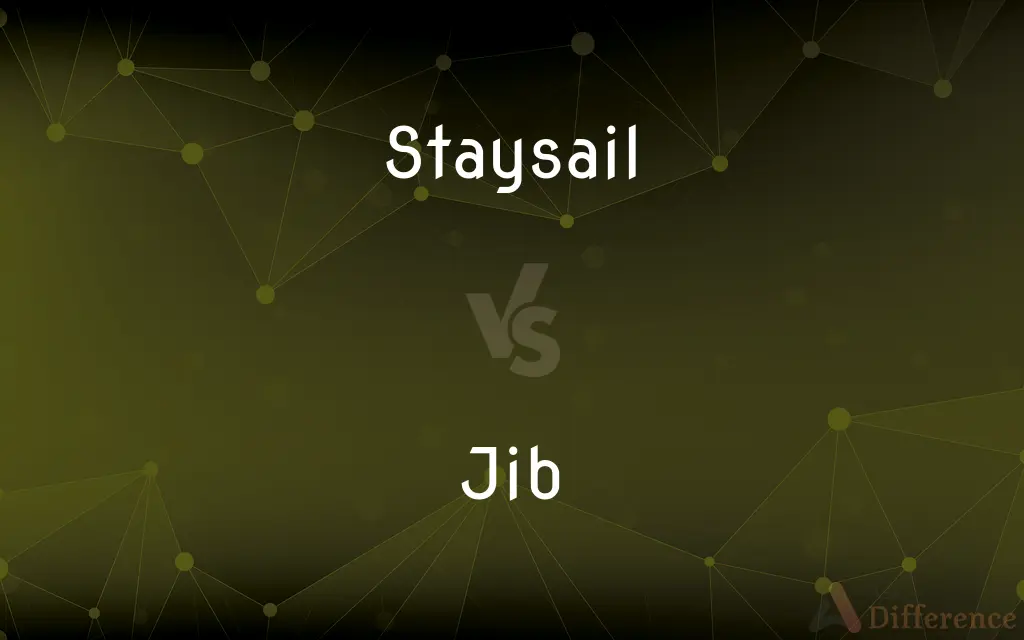Staysail vs. Jib — What's the Difference?
Edited by Tayyaba Rehman — By Maham Liaqat — Updated on April 8, 2024
Staysail is a supporting sail, positioned between the foremast and mainmast, enhancing sailing efficiency, while jib is a type of foresail, extending beyond the front of the ship, crucial for direction control.

Difference Between Staysail and Jib
Table of Contents
ADVERTISEMENT
Key Differences
Staysails are sails rigged on stays (wires) between masts on a sailing vessel, used to add extra sail area and improve performance, particularly on larger ships. On the other hand, a jib is a specific type of foresail that is mounted on the ship's front, projecting forward from the foremost mast, playing a key role in maneuvering and speed.
While staysails can be found on various parts of a sailing ship, providing versatility in sail configuration and improving balance and speed under different conditions, jibs are primarily focused on improving the ship's aerodynamics and are pivotal for steering, especially when tacking or gibing.
The rigging of a staysail involves securing it between masts or from a mast to the deck, offering a range of positioning that can adapt to various wind conditions and sailing plans. In contrast, jibs are attached to the bow's headstay, allowing them to catch wind from the forward direction, essential for maintaining speed and course.
Staysails are part of a larger sail plan and can be used in conjunction with other sails to optimize the vessel's performance, especially in upwind conditions. Jibs, however, are often used as the ship's primary means of propulsion along with the main sail, especially in smaller vessels or when navigating tighter courses.
The choice between deploying a staysail or a jib (or both) depends on the specific sailing conditions and the sailor's objectives, with staysails offering added power and jibs providing crucial control and speed enhancements.
ADVERTISEMENT
Comparison Chart
Definition
A sail set on a stay between masts or from mast to deck.
A type of foresail that extends forward from the front mast.
Primary Function
Adds sail area for improved performance.
Provides direction control and speed.
Rigging Location
Between masts or from mast to deck.
On the headstay extending from the bow.
Contribution to Sailing
Enhances balance and speed, especially upwind.
Crucial for maneuvering and aerodynamics.
Variability
Can be positioned in various configurations.
Primarily focused on forward propulsion.
Compare with Definitions
Staysail
Provides additional power and speed.
The staysail's addition gave us the extra push we needed.
Jib
A triangular sail extending from the ship's front.
The jib caught the wind, pulling us forward.
Staysail
Enhances sailing efficiency by adding more sail area.
The staysail was key in maintaining our speed against the wind.
Jib
Helps in steering, especially when tacking.
The skillful handling of the jib made tacking in tight spaces possible.
Staysail
Can be used in multiple configurations for versatility.
Adjusting the staysail improved the ship's balance.
Jib
Mounted on the headstay, crucial for direction.
Adjusting the jib helped us change course swiftly.
Staysail
A sail rigged on a wire stay between the masts of a ship.
The captain decided to hoist the staysail to catch more wind.
Jib
A primary sail used in combination with the mainsail.
With the main and jib raised, the boat sailed smoothly.
Staysail
Often part of a complex sail plan on larger vessels.
On the schooner, the staysail was hoisted between the foremast and mainmast.
Jib
Key to the boat's maneuverability and speed.
The jib's position against the wind maximized our speed.
Staysail
A staysail ("stays'l") is a fore-and-aft rigged sail whose luff can be affixed to a stay running forward (and most often but not always downwards) from a mast to the deck, the bowsprit, or to another mast (the mast is item 13 in the illustration right).
Jib
A jib is a triangular sail that sets ahead of the foremast of a sailing vessel. Its tack is fixed to the bowsprit, to the bows, or to the deck between the bowsprit and the foremost mast.
Staysail
A triangular sail hoisted on a stay.
Jib
(Nautical) A triangular headsail set with its luff fastened to a stay rising from the bow, bowsprit, or jib boom.
Staysail
(nautical) A fore-and-aft rigged sail whose luff can be affixed to a stay running forward from a mast to the deck, the bowsprit or to another mast.
Jib
The arm of a mechanical crane.
Staysail
Any sail extended on a stay.
Jib
The boom of a derrick.
Staysail
A fore-and-aft sail set on a stay (as between two masts)
Jib
To stop short and turn restively from side to side; balk.
Jib
To perform tricks by jumping onto and maneuvering over fixed obstacles such as railings or platforms. Used especially of snowboarders and skiers.
Jib
(nautical) A triangular staysail set forward of the foremast. In a sloop (see image) the basic jib reaches back roughly to the level of the mast.
Jib
Any of a variety of specialty triangular staysails set forward of the foremast.
Jib
The projecting arm of a crane.
Jib
A crane used for mounting and moving a video camera.
Jib
An object that is used for performing tricks while skiing, snowboarding, skateboarding, in-line skating, or biking. These objects are usually found in a terrain park or skate park.
Jib
One who jibs or balks, refusing to continue forward.
Jib
A stationary condition; a standstill.
Jib
The mouth, sometimes particularly the tongue, underlip, or tooth.
Jib
To shift, or swing around, as a sail, boom, yard, etc., as in tacking.
Jib
To stop and refuse to go forward (usually of a horse).
Jib
(figuratively) To stop doing something, to become reluctant to proceed with an activity.
Jib
A triangular sail set upon a stay or halyard extending from the foremast or fore-topmast to the bowsprit or the jib boom. Large vessels often carry several jibs; as, inner jib; outer jib; flying jib; etc.
Jib
The projecting arm of a crane, from which the load is suspended.
Jib
One that jibs, or balks; a jibber.
Jib
A stationary condition; a standstill.
Jib
To move restively backward or sidewise, - said of a horse; to balk.
Jib
To shift, or swing round, as a sail, boom, yard, etc., as in tacking.
Jib
Any triangular fore-and-aft sail (set forward of the foremast)
Jib
Refuse to comply
Jib
Shift from one side of the ship to the other;
The sail jibbed wildly
Common Curiosities
Can a sailing vessel have both a staysail and a jib?
Yes, many sailing vessels use both a staysail and a jib as part of their sail plan to maximize performance and control.
What is a staysail?
A staysail is a sail rigged on a stay, used to add sail area and improve sailing performance, particularly on larger vessels.
What is a jib?
A jib is a type of triangular foresail that extends beyond the ship's front, crucial for steering and speed.
In what sailing conditions is a staysail most beneficial?
A staysail is most beneficial in upwind conditions where additional sail area can help maintain speed and improve handling.
Is a staysail always necessary on a sailboat?
While not always necessary, a staysail can significantly enhance a boat's performance under certain conditions, making it a valuable addition to the sail plan.
Why is the jib important for sailing?
The jib plays a vital role in maneuvering and controlling the boat's direction, making it essential for effective sailing, particularly in changing wind conditions.
How does a jib affect a boat's aerodynamics?
The jib affects aerodynamics by directing airflow around the boat, aiding in propulsion and maneuverability.
How is a staysail rigged?
A staysail is rigged on a wire stay that runs between masts or from a mast down to the deck, allowing for versatile positioning.
What types of boats commonly use staysails?
Staysails are commonly used on larger sailing vessels and yachts that benefit from the additional sail area for balance and performance.
Can a staysail and jib be used together effectively?
Yes, using a staysail and jib together can provide a balanced sail plan that maximizes both power and control.
How do staysails enhance a sailboat's performance?
Staysails increase the sail area, offering more power and improving balance, which enhances the boat's overall performance, especially in upwind sailing.
What distinguishes a jib from other foresails?
A jib is distinguished by its location, extending forward from the ship's front mast, and its role in steering and speed, making it unique among foresails.
What skills are required to manage a jib effectively?
Managing a jib effectively requires skills in sail trimming, understanding wind angles, and precise steering to optimize the sail's performance.
How can a sailor decide when to use a jib?
Sailors typically use a jib for improved control and speed, especially when navigating tighter courses or in variable wind conditions.
Does the size of the jib matter in sailing?
Yes, the size of the jib can significantly impact the boat's handling and speed, with larger jibs providing more power but requiring careful handling.
Share Your Discovery

Previous Comparison
Presidentship vs. Presidency
Next Comparison
Emulsifier vs. StabilizerAuthor Spotlight
Written by
Maham LiaqatEdited by
Tayyaba RehmanTayyaba Rehman is a distinguished writer, currently serving as a primary contributor to askdifference.com. As a researcher in semantics and etymology, Tayyaba's passion for the complexity of languages and their distinctions has found a perfect home on the platform. Tayyaba delves into the intricacies of language, distinguishing between commonly confused words and phrases, thereby providing clarity for readers worldwide.















































